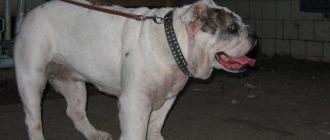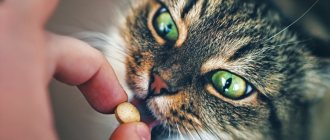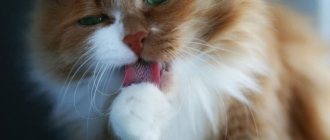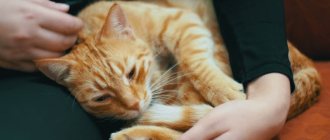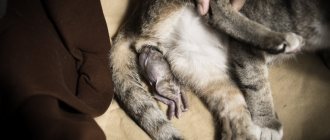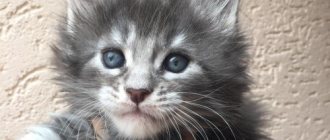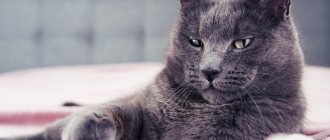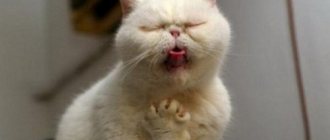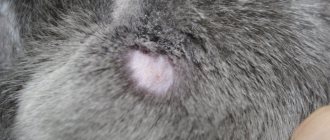A particular problem is an ingrown nail in a cat, due to which it loses the ability to climb trees, leave special marks and catch prey. It often happens that a pet pulls out a claw due to careless movement while sharpening it. If the nail digs into the pads, the pet experiences discomfort and pain, which is why it cannot move normally. You should not try to solve your cat’s problem on your own, as it will only make the problem worse. If a kitten or adult has twisted or broken its claws, it is recommended to consult a veterinarian.
Why delete?
There are several good reasons to favor declawing.
From a veterinary point of view, sometimes declawing a cat becomes a necessary measure if the claw is damaged without a chance of recovery or a tumor is found in this place. If an animal suffers from epilepsy, then during an attack it can injure itself. Removing claws will prevent animals from harming themselves.
Declawing
Owners with weakened immune systems and older cat owners who use blood thinners who receive scratches from their pet may be attacked by bacteria contained on/under the cat's claws. The consequences of such injuries will always be very serious.
Close attention from young children to a pet can provoke aggression in the animal. Injuring a child will prompt owners to remove the cat's claws.
But most declawing operations involve cats damaging interior items (furniture, wallpaper, etc.).
Clinical signs
The owner may suspect something is wrong if the pet frequently licks the problem paw.
When a cat's claw has grown into the pad, the owners may not always notice the pathology. If the nail is broken, dug in or falls off, the following symptoms of the disorder are observed:
- Appearance of lameness. If there is a violation, soft tissues are affected, as a result of which the cat experiences pain while moving.
- Increased attention of the pet to the damaged paw. The animal can constantly lick near the pad, and also tries to bite off a claw. The cat often approaches the owner with a request to stroke the chin and other parts of the body, since he cannot do it on his own.
- Refusal of outdoor games. Owners may notice that the cat begins to move and jump less.
- Swelling, redness and bleeding in the affected area.
- Anxiety upon palpation. If the owner tries to touch a torn or ingrown nail, the cat will begin to meow heavily, struggle, and may scratch.
- Pain syndrome. If a large or other claw becomes inflamed or festered, it can acquire a black tint and cause severe pain to the cat.
Why does a cat's claw grow into its pad?
Ingrown claws are more common in obese, inactive animals, and older pets. In the latter, due to age-related changes in the body, the exchange of minerals and salts is disrupted, which causes deformation of the claws, and they are less worn down due to the fact that the animals are not so active.
Impaired growth of claws and their deformation can be associated with a lack of vitamins and minerals, injuries and mechanical damage to the cat's paw. Ingrowth occurs when the horny formations are not worn down enough and due to improper, irregular care - infrequent haircuts, shortening to too short a length.
Deformation, abnormal growth and ingrown nails may indicate a fungal infection, symptoms of which also include darkening at the base, deterioration of the coat, the appearance of wounds between the pads of the fingers and bald spots on the body. The animal must be shown to the veterinarian as soon as possible. Infected claws are removed surgically.
Ingrowth leads to discomfort and pain in the paw, which is manifested by changes in the pet’s behavior:
- he often licks the pad and tries to gnaw out the claw;
- his gait changes - the cat steps carefully, becomes less mobile, and limps;
- sometimes in the places where he passed, you can see traces of blood;
- upon examination, a strongly grown, bent claw is discovered that has dug into the soft tissue (see photo above), sometimes the pad swells and turns red;
- if an abscess begins, pus is released and an unpleasant odor appears, the limb becomes hot;
- When you touch a problem area, the cat becomes anxious, breaks away and tries to bite.
Why is there a problem?
Veterinarians warn owners of elderly pets that ingrown nails and subsequent inflammation are more common in mature cats than in young cats. This phenomenon is associated with a lack of vitamins and beneficial microelements.
Nail-related disorders are often reported in pets. In some cats, the claw may simply be turned in the opposite direction; in others, it comes off completely. The problem is a consequence of the active lifestyle of the feline family, which often climb trees or sharpen their nails on furniture. Normally, the pad and nail plate of cats should not touch. When the claws grow quickly and become rough, the following factors can affect this:
- insufficiently active lifestyle;
- improper grinding of nails;
- mechanical damage, in which the owner notices that the cat has injured either a claw or it has completely come off;
- predisposition to pathology at the genetic level.
Claw amputation
Soft cat paw surgery is called an onychectomy. It is performed under general anesthesia. This is a relatively simple procedure and consists of amputating the first phalanx of the fingers, that is, the claw itself and the place from where it grows. The operation lasts about half an hour.
To the popular question of owners whether it is possible to remove a cat’s claws forever, we can give a positive answer if the operation is performed correctly.
If you are planning to remove the claws of a kitten, but you doubt at what age this operation can be performed on him, then there are no special restrictions. The main criterion is the kitten's ability to tolerate anesthesia, so it is advisable to conduct an examination before surgery.
At the same time, there is a lower age limit - no earlier than eight months. At this age, the cardiovascular system is already ready to tolerate anesthesia. As for the best psychological adaptation of the animal after surgery, the suitable age for surgery is from six months to a year.
Thus, according to two criteria, the most favorable time for onychectomy is the age of 8-12 months.
Cat with amputated claws
How to trim nails?
First of all, you need to understand that an inept approach to the nail trimming procedure can cause pain to the animal, and in some cases, health problems. Therefore, to begin with, we will look at the tools with which this can be done as correctly as possible, and then we will describe the procedure itself.
What can you use to cut your hair?
For safe and convenient trimming of cat's claws, several special devices have been invented and put on sale. They are called nail clippers and can be presented in two types: scissors and forceps.
Scissors
Special scissors for trimming cat claws can be purchased at a pet store or veterinary pharmacy. Outwardly, they are similar to ordinary scissors, but there is also a difference - the shape of the tool, thanks to which the claw is securely fixed and at the same time the risk of damage to it during cutting is reduced to zero. At the same time, the cutting surfaces of this device are somewhat reinforced, since the cat's claw is quite dense and hard.
These scissors are suitable for both adult cats and kittens
Nippers, or nippers, for trimming nails allow you to carry out the procedure itself very quickly. This device works on the principle of a guillotine - one confident sharp pressure and the tip of the claw is as if it were never there. The tongs cut it instantly, without cutting, breaking or sawing it.
As a result, the pet owner gets quick results, and the animal itself does not even have time to be “indignant” about everything that is happening. The cut is very neat, which makes these pliers a more “advanced” tool compared to scissors.
Cat nail clippers provide the best quality cut possible
How to cut your hair?
So, let's move on to the main thing - how to trim a cat's claws correctly. It is very good if your cat is half asleep during the procedure, in this case everything can be done quickly and efficiently. If you were unable to catch your pet half asleep, then wait until he has finished all his business, including games, and only then begin the procedure.
The procedure for cutting nails is carried out in the following sequence:
- Wash the hands;
- treat the nail clipper with alcohol or an alcohol-containing solution;
- take the cat in your arms and caress it - the animal should feel your goodwill;
- take your pet’s paw in your hand, this must be done confidently, but gently;
- press the center of the pad so that the claw opens;
- examine the claw in the light - this will allow you to see pink tissue, which in no case should be touched;
If the cat's claws are light, then the sensitive area will be clearly visible - trim the edge of the claw, leaving 2 mm to the pink tissue;
- repeat the procedure with the remaining claws.
We suggest you read: Treating constipation in cats at home
During the procedure, it is necessary to constantly talk to the animal and praise it, even if it does not behave entirely calmly. And at the end, don’t forget to treat your cat with her favorite treat.
The question of how often to trim a cat's claws will not have a clear answer. The frequency of this procedure may depend on a number of factors:
- the rate of growth of the claw plate, which depends on the characteristics of the animal’s body;
- the speed of claw growth depending on their color - light plates grow faster than dark ones;
- characteristics of the animal’s character and behavior - active cats will constantly sharpen their claws themselves;
While slow and lazy pets will simply lie on their favorite sofa, and, accordingly, their claws will sharpen much more slowly
Therefore, the owner must determine the frequency of the procedure independently, examining his pet’s claws from time to time.
Consequences of removal surgery
During amputation of the phalanges of the fingers, large blood loss can lead to the death of the animal. Also, this procedure can subsequently cause complications and problems associated with the health and psycho-emotional state of the pet. As with any operation, infection may occur in the wound (there is a risk of abscesses).
Possible changes in behavioral reactions (more often seen in adult cats):
- the pet may become unreasonably aggressive;
- he will nervously perceive the owner’s caresses;
- the animal will lose interest in games and food;
- he may begin to have problems with the cat's litter box.
Important! Do not allow a declawed cat to go outside. This will be cruelty to the pet since it will not be able to defend itself properly. After declawing a cat, owners should be committed to keeping the cat indoors for the rest of its life or finding a family that can provide such care.
Declawing a kitten can lead to:
- prolonged lameness;
- malaise;
- drowsiness;
- lack of appetite;
- temperature rise.
Lethargic cat
There is also a risk of joint disease (in adulthood).
But the most important thing is that the animal will suffer! Physical pain will haunt a declawed cat for a very long time (including phantom pain). Using the toilet in the first months after surgery will only cause pain, which is why the litter box will be perceived as something hostile.
As a result, the pet will look for soft and “safe” places. It will be more difficult to wean him from this habit than from the habit of scratching interior items.
In addition to physical suffering, the pet will suffer psychological trauma. Cats are predators by nature. For her, claws are both a means of defense and attack.
Declawing will cause depression in the cat, which will dramatically worsen the pet's general condition. It will take owners a long time to regain the cat's trust. Judging by the reviews of owners who have declawed their pet, in 75% of cases trust cannot be regained at all (especially in an adult cat).
Ingrown toenail in a cat: how to help your pet
Causes of ingrown claws
Pets that spend a lot of time outside wear down their claws naturally. On the front paws - on the bark of trees, on the hind paws - on the asphalt when walking. Domestic cats that do not leave the apartment love to sharpen their nails on furniture upholstery, wooden surfaces or walls.
With normal growth, the nail has a moderate bend and does not touch the paw pad with its sharp end. The cause of ingrowth is often the following factors:
- the cat's passivity, its inactivity;
- inability to properly grind off an overgrown nail plate;
- genetic feature;
- deficiency of micro- and macroelements in the body;
- injuries received from a fall or during physical activity.
With normal growth, the claw has a moderate bend
Veterinary studies have shown that the risk of developing pathology is significantly higher in adult cats than in young cats.
Symptoms and possible complications
It is quite easy to notice an ingrown claw in your pet. The problem is indicated by atypical behavior of the pet:
- Since the sharp tip of the nail injures the soft tissues, the animal develops noticeable lameness. Painful sensations do not allow the cat to fully step on the damaged paw, and therefore he begins to limp.
- The pet pays a lot of attention to the sore limb. He constantly licks his foot and tries to bite off the offending nail with his teeth.
- The pet becomes inactive, lies down more, and does not show interest in regular games.
If you notice uncharacteristic behavior, you need to carefully examine your pet's paws. An ingrown nail is usually longer than the rest, strongly curved, and often stuck into soft tissue. When a mechanical impact is applied to the pad, the cat becomes aggressive, hisses, bites, and tries to escape from the hands.
If the problem is not corrected, it can adversely affect the quality of life of the furbaby:
- he will have a constant feeling of discomfort;
- pain or discomfort;
- habitual activity and mobility will be forced to decrease;
- lameness and unsteadiness of step will appear.
When an infection gets into the wound, inflammation often begins. If no action is taken, an abscess may develop, which can lead to sepsis.
Video “How to trim a cat’s claws?”
In this video, veterinarians explain how to care for your pet.
Treatment at home
Owners who have never encountered the problem of an ingrown claw often make the same mistake - they try to pull it out manually. You shouldn't do this. Veterinarians advise not to rush, but to carry out the removal procedure, following all the rules:
- Disinfect nail clippers with alcohol;
- secure the cat so that it does not escape and accidentally bite your hand;
- thoroughly wipe the damaged pad with an antiseptic;
- carefully trim the nail, trying not to damage the part where the capillaries begin;
- if the sharp tip has grown into the soft tissue, carefully remove it with tweezers (you need to pull the claw out of the pad with a sharp, quick movement in the opposite direction of growth);
- treat the wound with hydrogen peroxide;
- apply a bandage with antibacterial ointment and stick it with a bandage;
- Carefully sharpen the trimmed nail with a nail file, smoothing out any sharp spots.
Help at the veterinary clinic
The extent of surgical intervention is determined by the doctor after a thorough examination of the animal. He evaluates the depth of the ingrowth, the degree of inflammation, and the general condition of the cat. If there are no complications, the doctor removes the problematic nail with a special tool, having previously treated the pad with an antiseptic. If inflammatory processes have already begun to develop, the operation is performed under local anesthetic. During the procedure, the veterinarian opens the abscess to remove the claw, pus, and clean out the wound. But very advanced cases require general anesthesia.
After the manipulations, the doctor applies a sterile bandage with antibacterial ointment to the furry patient. To neutralize the inflammatory process, he prescribes a course of antibiotics, and for a speedy recovery, he prescribes mineral and vitamin complex preparations. If the animal is too weakened, it adds drugs that strengthen the immune system to the treatment regimen.
During the rehabilitation of the furry, it is necessary to regularly change the bandages. At the same time, you should not glue them with adhesive tape, so as not to further injure the surrounding tissues. If the cause of an ingrown toenail is genetic, the problem is likely to recur. During a relapse, it is best not to treat the animal yourself, but to contact a veterinarian for a second course of treatment.
After the manipulations, the doctor applies a sterile bandage to the cat.
Prevention of ingrown claws
No pet is immune from re-ingrowing nails, no matter how old they are. You can reduce the risk of a problem occurring by:
- install a device for grinding nails;
- give your furry manicure regularly;
- If the claws are irregularly shaped or have growth problems, have them trimmed by a specialist;
- avoid traumatic situations where the cat may damage its paws;
- Closely monitor the health and behavior of your pet, especially an older one.
When cutting nails, you should not forget about the fifth finger, which is located on the forelimbs just above the main four. This is where the problem of ingrowth most often arises.
To prevent manicure from causing severe stress for your pet, it is best to accustom him to the procedure from an early age. The cutters must be in good working order, well sharpened, and disinfected. Otherwise, there is a risk of delamination of the nail plate. The trimming manipulation itself consists of several steps:
- pre-treat hands and manicure tools with antiseptic;
- gentle stroking calms the cat;
- place it comfortably on your hands, fixing the position;
- taking the limb, lightly press on the foot so that the claws are clearly visible;
- the nippers are placed perpendicular to the nail plate, just above the area where the blood capillaries begin;
- cut the nail with a sharp, quick movement;
- Use a nail file to carefully smooth out the sharp edges.
If blood vessels were damaged during pruning, which led to bleeding, the damaged area should be treated with an antiseptic and a swab with hydrogen peroxide should be applied.
Trimming cat claws is a mandatory pet care procedure, which is the main method of preventing ingrown nail plates. By following all the rules, a manicure can be done quite quickly without causing discomfort to your pet.
What to do at home?
If the problem is not complicated by inflammation and an abscess, as evidenced by redness, swelling of the tissues and the release of purulent exudate, it can be dealt with at home.
To help your pet you will need special nippers, alcohol (cologne, vodka), and for subsequent treatment of the wound - hydrogen peroxide, a weak solution of potassium permanganate or furatsilin. The procedure is quite painful, so the animal will break out and bite. It is important to hold it well in such a way that it does not cause harm. You can hire an assistant if you are unable to secure your pet yourself.
The nail clipper is wiped with a disinfectant liquid, and the damaged area is also treated with it. The claw is trimmed by placing the tool perpendicular to it, after which the ingrown part is carefully removed from the soft tissues with hands or tweezers, and the pad is disinfected. When cutting, it is important not to damage the blood vessel. It is easy to notice - under the translucent claw this pink area is clearly visible.
Problems with cat claws
In fact, cats are quite easy to care for, but this does not mean that no problems will ever arise with them. There can be many unpleasant situations, and today we will describe some of them.
Ingrown claw
An ingrown nail in a person is far from uncommon, but not many people know that a cat’s claw can grow into the pad. This defect occurs due to the large, long nail plate and its curved shape.
The fact is that the claws grow from the top of the pad and bend downward. But at their normal length, contact with the pad does not occur, and if the plate grows too long, then it pierces the soft base of the paw and grows into it.
An ingrown claw is very unpleasant and quite painful.
This often happens when the cat is at an “advanced” age and has never had its claws trimmed or has had it done very rarely. In old age, the shape and structure of the claws begin to change, and irregular care in addition to this leads to its ingrowth.
What can be done in this case?
- If there is no serious wound, then you need to carefully cut off the end of the claw, without touching the body with blood vessels, remove the cut part from the pad, and treat the paw itself with hydrogen peroxide.
- If there is serious damage to the soft part of the paw, you should take the animal to a veterinary clinic. In this case, it may be necessary to completely remove the claw plate, after which the specialist will treat the wound with an antiseptic and prescribe antibiotics.
We invite you to read: The death of a cat - how to survive, different opinions and advice Video
Claw delamination
If a cat's claws are peeling, then, first of all, it is necessary to establish the cause of what is happening. They may be as follows:
- the claws grow and at the same time their stratum corneum is renewed - in this case, a scaly capsule begins to envelop the claw, which after a while comes off and delamination occurs. This can be easily eliminated at home using a scratching post;
- insufficient care after cutting - a carelessly performed procedure can cause injury to the claw plate;
- lack of vitamins – a cat’s diet must be balanced, and a lack of nutrients often provokes dehiscence of claws.
The first reason is natural, so it is the next two that require the owners’ attention.
Delamination of the claw plate can be prevented with the help of anti-scratches. They are made of soft silicone and are absolutely safe for animals.
Be attentive to your pets and try to give them as much free time as possible. And if a problem with claws is detected in the first stages of development, it will be quite easy to eliminate it.
Rehabilitation
The duration of the postoperative period is about a week. All this time:
- There should be bandages on the pet’s paws;
- the cat must be wearing a special collar;
- the cat must be in a cage, which will limit its movement;
- sand/soil should not be used in the litter tray (plain paper can be used).
Cat with bandages on paws
For the next few weeks, or even months, the pet should be surrounded by the attention and care of the owners, because it is extremely difficult for him to get used to the new condition. This is a time of increased animal injury.
Symptoms and possible complications
It is quite easy to notice an ingrown claw in your pet. The problem is indicated by atypical behavior of the pet:
- Since the sharp tip of the nail injures the soft tissues, the animal develops noticeable lameness. Painful sensations do not allow the cat to fully step on the damaged paw, and therefore he begins to limp.
- The pet pays a lot of attention to the sore limb. He constantly licks his foot and tries to bite off the offending nail with his teeth.
- The pet becomes inactive, lies down more, and does not show interest in regular games.
If you notice uncharacteristic behavior, you need to carefully examine your pet's paws. An ingrown nail is usually longer than the rest, strongly curved, and often stuck into soft tissue. When a mechanical impact is applied to the pad, the cat becomes aggressive, hisses, bites, and tries to escape from the hands.
Pet constantly licks foot
If the problem is not corrected, it can adversely affect the quality of life of the furbaby:
- he will have a constant feeling of discomfort;
- pain or discomfort;
- habitual activity and mobility will be forced to decrease;
- lameness and unsteadiness of step will appear.
When an infection gets into the wound, inflammation often begins. If no action is taken, an abscess may develop, which can lead to sepsis.
How can they help at the veterinary clinic?
If for some reason it is not possible to provide assistance at home, or if there is bleeding, inflammation or an abscess, you must contact a veterinary clinic. If there are no complications, the doctor acts in the same way as described above - trims and removes the claw, treats the pad with an antiseptic.
Surgery is usually performed under local anesthesia. With deep ingrowth and spread of the inflammatory process to nearby tissues, surgery under general anesthesia may be required. To avoid wound infection, antibacterial drugs are prescribed. To maintain the pet’s body, prevent infections and inflammation, and rapid tissue regeneration, immunomodulators and vitamin-mineral complexes are used. The animal should not be allowed outside until the wound has completely healed.
Treatment by a veterinarian
In specialized veterinary institutions, experienced doctors will be able to provide assistance, even if the nail has grown deep enough. During the initial examination of the patient, the doctor determines the degree of ingrown nails, decides whether surgery is necessary, and its complexity.
If the defect is not aggravated by inflammation of the surrounding tissues, then the veterinarian will remove the ingrown nail using special tools. To avoid the inflammatory process, the site of ingrowth is treated with an antiseptic solution. In cases where inflammation has already begun, the pad has turned red and festered, the doctor opens it. The operation is performed under local anesthesia.
In particularly difficult situations, surgery is performed under general anesthesia. An incision is made through which the nail is removed, the wound is washed from accumulated pus, and treated with antiseptic drugs. At the end of the procedure, a sterile bandage is applied.
While the wound is healing, the cat is prescribed antibiotics and supplemented with mineral and vitamin complexes. To strengthen the immune system, it is recommended to take immunomodulators that promote rapid healing and tissue restoration. Walking is temporarily contraindicated for your pet. The room in which the cat is located must be clean.
© shutterstock
The owner must closely monitor the wound healing process and nail growth. If the situation repeats, you need to consult a doctor who will prescribe additional treatment.
Alternatives
The overwhelming majority of cat lovers, felinologists and veterinarians are of the opinion that since cats are born with claws, they should remain with them. Some people believe that it is unnatural to remove a cat's claws to please the owner.
There are many arguments in support of this opinion. For example, the pain and suffering that pets go through, complications after surgery. Therefore, cat lovers and veterinarians look at this procedure as a last resort. But if owners want to give up their cats, euthanize them, or kick them outside due to the damage caused by claws, then cat onychectomy is an option to prevent this.
There are alternatives to declawing. One of them is teaching your pet to sharpen its claws in a designated place (on a scratching post or a specially covered board with hard fabric). This is a very effective method, but less successful when living with older cats.
There are also vinyl, rubber and silicone cat claw caps (set of 20). The service life of the caps is 1.5-2 months. They are put on using surgical glue, and cats usually get used to them within a day or two. But the glue must be applied correctly to the trimmed claws.
Owners sometimes glue several fingers together when they try to do this procedure themselves. Therefore, entrust the labeling of the caps to a professional who can also select the correct size.
Important! If your cat goes outside, the lifespan of the caps will be significantly reduced.
Trimming claws is also an alternative to removing them. If you do this weekly, it will solve the problem of people scratching, but it will not stop your cat from damaging the furniture. In addition, she will want to sharpen her trimmed claws more often.
What should the owner do?
Detecting a disease in an animal is not so difficult. The owner will first notice the lameness of the pet. A deformed nail that affects the soft tissues of the paw causes anxiety and pain for the cat when walking. The animal begins to limp and carefully step on the sore limb.
The owner may also notice that the cat is showing increased attention to the sore paw - trying to bite off the nail, often licking the crumb of the limb.
Upon visual inspection, a long curved claw is observed, the sharp edge of which is embedded in the soft tissue of the paw. The owner may notice swelling and redness around it. When palpating a pathological focus, the animal shows anxiety due to pain: it breaks out, hisses, and may bite.
Having discovered such symptoms, the owner is able to help only if the ingrown nail has not led to inflammation of the surrounding tissues. To do this, you need to arm yourself with special nippers for trimming animal claws (a guillotine-type nail clipper will not work in this case).
After treating the instrument with disinfectant solutions, you should trim the ingrown claw without affecting the pink area where the capillaries pass. Grasping the ingrown part with tweezers or the edges of nippers, you should carefully remove it from the soft tissues of the paw. This should be done in a movement opposite to the direction of ingrowth.
After the defective nail is removed from the paw pad, the damaged area must be treated with antiseptic solutions: hydrogen peroxide, Furacilin solution, Chlorhexidine, etc. After removing the fragment from the paw, you need to use a nail clipper to shorten the cat's claw again.
If, upon examination of the paw, swelling and redness are detected at the site where the claw is inserted into the tissue of the limb, you should not make independent attempts to help the pet. The owner needs to contact a specialized agency.
Caring for your cat's claws and preventing them from becoming ingrown
Proper, systematic care of your cat's claws reduces the risk of ingrown nails to zero. First of all, they need to be inspected regularly. Particular attention is paid to elderly pets, animals that are overweight, and those who have had an ingrowth before, since their risk of developing a defect is higher. Especially often, the claw grows on the fifth toe of the front paws, which is located a little further from the rest, since it does not grind down when walking.
Nails need to be trimmed periodically. The frequency of the procedure is determined by how quickly they grow. On average, pruning is required once every 2-3 weeks. You need to get used to grooming from childhood, then an adult pet will calmly tolerate the procedure.
The haircut is done as follows:
- The cat is fixed in a comfortable position.
- Press on the paw pad so that the claws appear.
- The location of the blood vessel is assessed and the claw is cut 2 mm from it. The nail clipper is positioned at a right angle to the claw so that the cut is even.
- Treat the trimmed tip of the nail.
Since injuries to the limbs can lead to deformation of the claws, it is necessary to protect the animal from possible dangers and do not leave windows open. A pet that does not leave the house needs to purchase a scratching post. The larger its size, the better. It should not be smaller than the cat itself. The most suitable materials are sisal and jute - these are natural fibers, safe and wear-resistant. To attract a pet, it is treated with special sprays.
Causes of ingrown claws
Pets that spend a lot of time outside wear down their claws naturally. On the front paws - on the bark of trees, on the hind paws - on the asphalt when walking. Domestic cats that do not leave the apartment love to sharpen their nails on furniture upholstery, wooden surfaces or walls.
With normal growth, the nail has a moderate bend and does not touch the paw pad with its sharp end. The cause of ingrowth is often the following factors:
- the cat's passivity, its inactivity;
- inability to properly grind off an overgrown nail plate;
- genetic feature;
- deficiency of micro- and macroelements in the body;
- injuries received from a fall or during physical activity.
With normal growth, the claw has a moderate bend
Veterinary studies have shown that the risk of developing pathology is significantly higher in adult cats than in young cats.
This is interesting: What to do if a cat has enlarged kidneys?
Proper nail trimming - how to do it to avoid problems?
If your cat's nails peel after trimming, you will have to understand the specifics of the procedure in order to avoid troubles in the future. The first thing to remember is that using ordinary scissors is prohibited. For manipulation, it is recommended to purchase special tweezers designed to shorten the stratum corneum. Step-by-step procedure:
- Wash your hands thoroughly.
- Make sure the tweezers are sharp and sharpen them a little if necessary.
- Disinfect the instrument.
- Remove only the tip of the claw, leaving a significant distance to the pink tissue.
Pay special attention to the fifth toe of your pet - the nail on it is much shorter than the others, so it is easy to injure the pad on the animal’s paw, it begins to peel and hurt. Here you need to shorten the nail plate often - since the keratinized tissue is practically not ground off, you will have to use tweezers. Lack of trimming can cause the nail to grow into the pad, resulting in pain and even injury to the cat.
Proper nutrition – what to include in your pet’s diet
If your cat's nails are split, immediately review your pet's daily menu. You should not delude yourself and believe beautiful advertisements - even the most balanced food will not replace ordinary meat, vegetables, fish, and dairy products. A pet's diet should consist of the following products:
- fresh meat;
- boiled vegetables;
- fish (fresh river fish is not recommended; it is better to boil it first, otherwise there is a risk of infecting the animal with worms);
- porridge;
- soups (remove fat first);
- dairy products (do not give milk in its pure form, the cat may develop diarrhea).
It would be a good idea to introduce vitamin complexes into the diet, especially if owners prefer to pamper their pet with store-bought food. It is better to find out from your veterinarian which vitamins are responsible for the good condition of the nail plates. You can replace vitamins with cereals, which contain all the elements necessary for a pet. Most often, oats are used, which are recommended to be pre-sprouted. You need to add chopped greens to your main feed at least once a week. For an adult cat, the dosage of green gruel is at least 15 g.
Be sure to include cod liver in your cat’s diet, which contains substances necessary for good growth and to prevent cracking of nail tissue. Do not heat treat the product; during cooking, some of the beneficial elements disappear.
Usually, regular nail trimming, proper diet and frequent walks, which allow the cat to wear off dead tissue, are enough to forget about the problem for a long time. If this does not happen, the nail plates continue to separate, and you will have to give up trying to help your pet on your own and go to the veterinarian.
It is necessary to find out what this process is connected with in order to understand what to do in this case and what measures should be taken to treat claw delamination.
First, let's look at the main points:
Prevention measures
The problematic situation with the pet's paws may recur. To prevent such a disease, you need to properly take care of the cat’s health and the condition of its claws:
- provide the pet with the opportunity to grind them down naturally, purchase a special device - a scratching post;
- regularly trim and file them to the optimal length;
- in case of deformation, it is better to have the pruning done by a professional to correct the shape and prevent ingrowth;
- protect the cat from injury and damage to its paws;
- An older cat should be given special attention. It has been noticed that in older animals the problem of ingrown claws is much more common.
Prevention of ingrown claws
How to properly trim the claws of a kitten and an adult cat
No pet is immune from re-ingrowing nails, no matter how old they are. You can reduce the risk of a problem occurring by:
- install a device for grinding nails;
- give your furry manicure regularly;
- If the claws are irregularly shaped or have growth problems, have them trimmed by a specialist;
- avoid traumatic situations where the cat may damage its paws;
- Closely monitor the health and behavior of your pet, especially an older one.
When cutting nails, you should not forget about the fifth finger, which is located on the forelimbs just above the main four. This is where the problem of ingrowth most often arises.
To prevent manicure from causing severe stress for your pet, it is best to accustom him to the procedure from an early age. The cutters must be in good working order, well sharpened, and disinfected. Otherwise, there is a risk of delamination of the nail plate. The trimming manipulation itself consists of several steps:
- pre-treat hands and manicure tools with antiseptic;
- gentle stroking calms the cat;
- place it comfortably on your hands, fixing the position;
- taking the limb, lightly press on the foot so that the claws are clearly visible;
- the nippers are placed perpendicular to the nail plate, just above the area where the blood capillaries begin;
- cut the nail with a sharp, quick movement;
- Use a nail file to carefully smooth out the sharp edges.
If blood vessels were damaged during pruning, which led to bleeding, the damaged area should be treated with an antiseptic and a swab with hydrogen peroxide should be applied.
How is declawing done in cats and is it worth it?
Trimming cat claws is a mandatory pet care procedure, which is the main method of preventing ingrown nail plates. By following all the rules, a manicure can be done quite quickly without causing discomfort to your pet.
